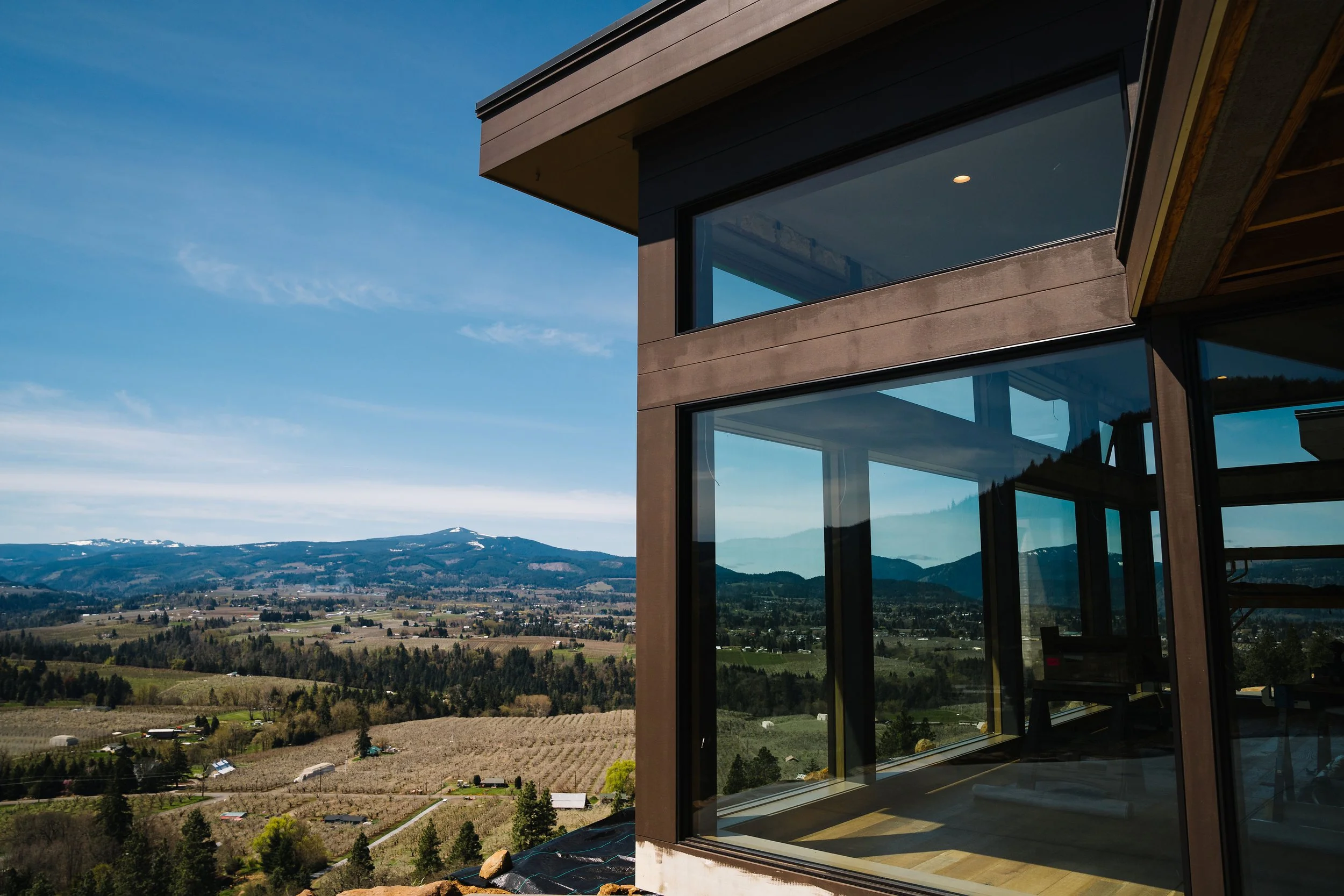Residential Green Roofing, a Growing Trend
Advertisement
Installing vegetated roofing on single-family residences is a rapidly increasing trend across North America. For the past 15 years, the green roof projects I have worked with were mostly on large commercial facilities such as municipal buildings and hospitals. The residential structures I encountered were multi-tenant buildings like condos and apartments, with reports that the units fill faster, stay full longer, and lease or sell for more per unit if the residents have access to a green rooftop amenity space.
Houses with spectacular views. Hood River Residence. Photo: Ty and Chey Photography
There were a few green roofs on single family residences along the way, mostly on the sprawling mansions of famous people with unlimited budgets. But there has been a shift recently with designers of new houses incorporating vegetated roofs into their plans. In the past two years, I have received many calls from developers, architects, and building owners inquiring about what it would take to install a green roof on their new house or housing development. These are much more modest family residences than the sprawling green-roof adorned palaces in Beverly Hills, though the homes are still generally on the higher end. When I inquire about why the owner or designer is interested in green roofing, the most common reasons are stormwater management, aesthetic value, and insulation.
In Arizona, the green roof interest comes primarily from the insulation and the cooling effect in an otherwise very hot environment. On the Pacific Coast, green roofs are replacing nature that was cleared for the building site, providing uninterrupted vegetated views from the forested cliffs to the ocean below. A developer of a neighborhood in Florida wants all of the new houses to have hurricane-strength green roofs to provide a nice view from the second story windows, overlooking what would otherwise be exposed roofing on the garages.
These are the words of an architect designing a home with a green roof for his own family residence:
“I went to college in Norway where vegetated roofs are exceptionally common. Besides how cool a grass roof house looks, the biggest benefits may be in its natural insulation properties while potentially lasting hundreds of years with almost no maintenance.”
The Hood River Residence perched on the side of a steep hill. Photo: Ty and Chey Photographers
Despite the huge variety in green roof systems as far as vegetation, types of components, and reasons for the install, all green roofs share the benefit of managing significant amounts of the precipitation that falls on the building. Depending on how they are designed, green roof systems can indefinitely hold water in cisterns, in deep trays under the plants, or funnel it toward the drains for use in grey water systems. Most green roofs do not retain all of the precipitation that falls, but slowly release it into the drains after it has percolated through the vegetation, growing media, drainage layer and other water storing components. In many jurisdictions, excess rainwater can be captured at the drain pipe and overflow scuppers for other uses such as in fountains, to flush toilets, for rain gardens or irrigation.
One of the most inspiring residential projects I have been involved with recently is a new home in Hood River, Oregon. The house can only be described as stunning, with clean lines and massive windows framing enchanting views of Mount Hood. The house was designed by Hood River architects Liz Olberding in collaboration with Miloš Jovanović of Spatial Studio LLC, and built by general contractor Craft Homes Northwest. It is on a hillside, with the driveway descending from above so that the full span of the vegetated roof is the first impression you get as you arrive at the gorgeous property.
The designers had fun with the stormwater management on this house, using overflow scuppers on the penthouse roofs that empty onto the lower vegetated roof. These drain features are strategically placed so that the resulting waterfalls can be viewed through windows from inside the home.
Hood River is one of the wind-surfing capitals of North America, situated along the breezy and sometimes destructively windy Columbia River Gorge. The residence itself is perched on the edge of a steep hill above the already deep river canyons, so wind uplift is a primary concern here. However, the weight of the pre-grown vegetated tiles and creative use of parapets and vegetation-free zone minimizes the wind impact to the system. There are a dozen species of shallow-rooted sedum growing together in a thick mat holding the plants and growing medium in place, similarly to how the roots of mangrove trees retain sand and protect coastal ecosystems during tropical storms in the Gulf of Mexico.
Advertisement
Lakeside Village Student Housing at University of Miami. Photo: GreenRise
The University of Miami has helped pave the way for the use of residential green roofing in high-wind areas, with the 25 green roofs they installed on their Lakeside Village student housing complex in 2019. With the strategic use of steel cables, wire mesh, and vegetation-free zones, these roof meadows received a Notice of Acceptance from Miami-Dade County with some of the most stringent wind uplift resistance criteria in North America. Similar High Velocity Hurricane Zone (HVHZ) green roof systems, including the plants, pavers, and roofing are being recreated in other areas with wind uplift concerns such as on high-rise buildings, in cities with lake-effect winds, and in mountainous regions, adjusted for local codes and climate conditions.
Most modern green roofs are on low-sloped or “flat” roof decks and not traditional steep-sided roofs. This is due to the obvious concern of the system sliding off of an incline (although there are bracing systems that can prevent this from happening), also the lower structural weight capacity of steep roofs, and limited access for maintenance.
As with commercial green roofing, it is critical to have a residential roof deck that can support the weight of the vegetated system and any live loads. It can be prohibitively expensive to build up an existing residential roof deck, but much easier to add loading capacity during the early design phase in new construction.
Vegetation-free zones surround all perimeters, penetrations and drains. Photo:Ty and Chey Photography.
There are several waterproofing options that can be used on residences which can withstand the constant moisture and hydrostatic conditions under green roofing, including hot rubberized asphalt and cold fluid-applied waterproofing like polyurethane-methacrylates. It can be a challenge to find a qualified installer for these low-sloped roofing products. They are most commonly used on large commercial sites and not small residences, which require a different skill set and equipment. But as the single-family green roof market grows, residential roofers are expanding their product lines to offer these highly durable waterproofing systems.
Maintenance is important to consider from the earliest design phase on residential green roofs. There should be a method for frequent, safe access to the roof either through a door, roof hatch, or stairwell. Regular maintenance to prevent pioneering species from establishing and going to seed will strengthen an extensive green roofs’ ability to resist weeds as it becomes firmly established with 100% coverage. Maintenance on residences is similar to commercial buildings including keeping drains and vegetation-free zones clear of debris, pulling weeds, and watering when needed.
Even with the added design and maintenance considerations, vegetated roofing on single family residences is a growing trend that may soon be on par with commercial green roof coverage, as installers and designers become more experienced and the waterproofing products more widely available. As they have done on the larger commercial buildings, green roofs are changing the nature of how we approach modern residential construction and providing homeowners with many tangible benefits, from added amenity spaces to managing water.
Advertisement
Elizabeth Hart Morris, GRP, CDT is a green roof consultant working with architects, developers, and roofers to support the design, install and maintenance of vegetated roofing systems across North America. Her consulting firm is Green Up LLC.








